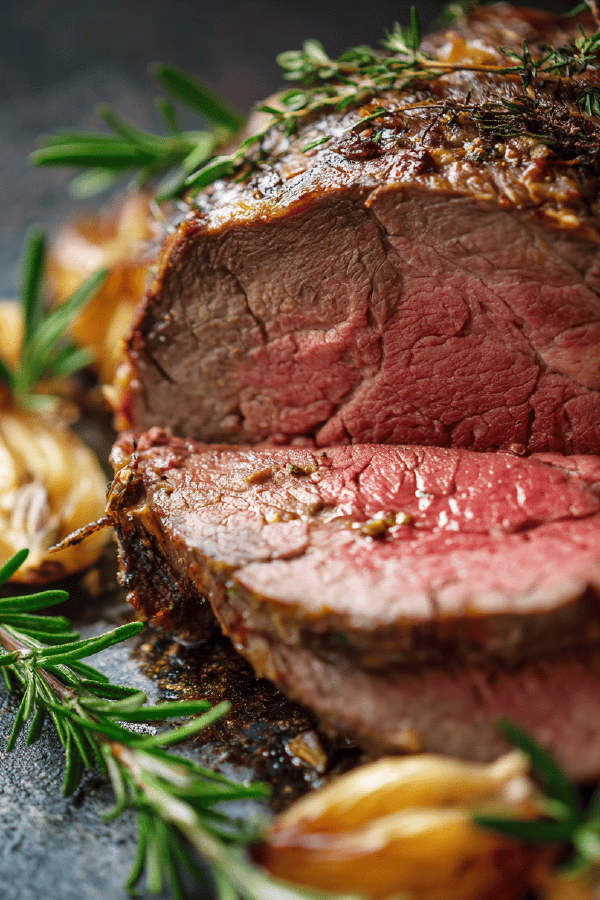Featured Recipe
Slow-Roasted Beef Twist

By Kate
"
Large beef roast browned then cooked low and slow. Onion and garlic form a rich bed, wine and herbs add depth. Butter swapped for duck fat, red onion replaced with shallots for subtle sweetness. Fresh rosemary instead of dried thyme. Slightly adjusted times for tenderness. Resting carefully, thin slicing. Serve with a rustic mash or root veggies.
"
Prep:
20 min
Cook:
Total:
Serves:
6 servings
beef
roast
French cuisine
winter recipes
Introduction
Beef whole chunk. Low heat slow roast. Patience rewarded. Crisped outside caramelized deep spots. Inside tender. Shallots swap for red onion gives softer edge. Duck fat richer than butter yet subtle. Rosemary fresh punch not dried thyme. Garlic mingles deep. Wine steams up aroma. Thermometer crucial. Don’t rush. Resting redistributes juices. Thin slicing mandatory, almost paper thin. Sauce rich, wine reduced, beef essence. No fluff, just basics. Mashed potatoes on side or parsnip mash. Roots in winter, warmth on plate. Rustic, simple elements. No frills here. Adapt but keep essence. Nothing fancy, purely the beef experience.
Ingredients
About the ingredients
Adjust the beef cut to inside round but lighter at 1.4 kg, cutting down from 2 kg reduces overall cooking time slightly yet keeps serving size intact. The oil gets bumped up slightly for better searing coverage. Duck fat replaces butter adding earthiness and subtle gamey note, excellent with red meat. Shallots sub as they caramelize softer than red onions, avoid any harshness while keeping sweetness. Use fresh rosemary springs over thyme — pungent, pine-like aroma freshens thick flavors. Bay leaf stays to keep herb complexity. The wine amount is slightly reduced concentrating flavor, use dry red wine or even a Bordeaux blend if you can. Salt and pepper seasoning needs to be generous upfront as it affects crust and internal seasoning. Garlic remains fine minced to infuse without overpowering. This creates a slow roasted roast with nuanced yet earthy rich profile, stripped of excess but not character.
Method
Technique Tips
Oven placement important mid rack ensures even radiant heat. Temperature is bumped a little to 145°C from 140°C for marginal faster cook but still gentle enough to avoid drying. Browning all sides is critical for flavor via Maillard reaction, so take time and don’t crowd pan. Duck fat melts and picks up beef juices better than butter at searing temps and adds richness. Sweating shallots low heat no color preserves sweetness, garlic added late to avoid burning. Deglaze wine introduces acidity lifts caramelized pan bits. Put veggies and liquid in roasting pan under rack to keep roast out of liquid, also captures drippings for sauce. Meat thermometer inserted center thickest bit watches tempo. Target 57°C for rare, internal will rise to 62°C after resting, which takes 20 minutes tented in foil. Resting crucial to redistribute juices. Slice very thin across grain will make chew easier. Sauce can be strained or served rustic. You may reduce sauce further or thicken with a touch of flour or cornstarch, but this risks overshadowing the simple beef base. Pair with classic root vegetale mash or rustic potatoes, keep side simple to center roast flavor. Timing is approximate; check temp regularly.
Chef's Notes
- 💡 Start by drying roast well. Salt generously. Repeat with pepper. Heat pan hot, oil sizzling. Sear each side thoroughly. Don’t rush this. Maillard reaction key. Oily flavor enhances. Patience is vital. Crust forms texture. Taste balance.
- 💡 Shallots are sweet. Use them over traditional onions for a softer bite. Caramelization happens slowly. Avoid browning. Garlic later in cooking, burns easily. Watch closely. Deglazing is crucial. Helps lift flavors, acidity in wine brightens mixture.
- 💡 Make sure oven placement is mid rack. Even cooking essential. Pan juices should stay out. Put veggies below the roast. Captures drippings for sauce. Insert meat thermometer in thickest part. Cook to 57°C. Rest for 20 mins; temp rises.
- 💡 Slice against grain for tender bites. Thin slices preferred. They melt in mouth. Sauce can be reduced, or just strain it. Simplicity holds flavor. Mashed potatoes work handsomely. Root veggies bring depth. Keep sides rustic and simple.
- 💡 Duck fat is better than butter in heat management. Rich flavor emerges. Don’t skip this swap. It’s essential for depth. Wine variety matters; select dry. Focusing flavor intensity in sauce enhances roast experience without overpowering.
Kitchen Wisdom
How to ensure roast is tender?
Stick to slow cooking temps. Monitor internal closely. Use thermometer. Rest after cooking. Juices redistribute. Keep it simple with seasonings. Add little liquid.
Best wine for this roast?
Dry red works best. Full bodied wines enhance flavor. Bordeaux blends suit well. Less acidity better for balance. Avoid sweet wines, they clash. Remember, strong flavor profiles are essential.
Common issue with roasts?
Dry meat often from high temps. Don’t rush it. Watch the thermometer closely. Also consider resting time; juices need flow back into meat. Cooling helps keep moisture.
Storage tips for leftovers?
Wrap tightly in foil or air-tight container. Refrigerate immediately. Lasts up to three days. Reheat gently. Don’t microwave; it toughens meat. Allow resting post reheating.



